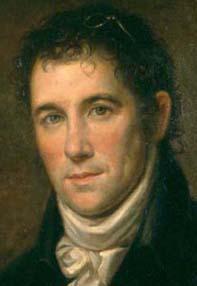- Home
- Archival Material
- College History Projects
- Subject-Based Digital Projects
Benjamin Henry Latrobe (1764-1820)

Benjamin Latrobe was born in Fulneck, England on May 1, 1764. His father, also named Benjamin, was a Moravian and ran a school in Fulneck that attracted pupils from as far away as the American Colonies. The elder Benjamin married one of his pupils, Anna Margaret Antes from Germantown, Pennsylvania. The couple's third child, Benjamin Henry, studied in England and later in Germany, where family legend holds that he served in the Prussian cavalry. He returned to England in 1786 and began his study of architecture under Samuel Pepys Cockerel - then championing the Greek revival - and engineering under John Smeaton. Latrobe began his own practice soon after and made impressive professional headway with his appointment as surveyor of the police office in London. He married Lydia Sellon in 1790 and the couple had two children, Henry and Lydia. His wife's death during childbirth in 1793 caused Latrobe to suffer a breakdown that ultimately led him to emigrate to Virginia.
Latrobe had an immediate impact on architecture in Virginia. He later moved on to Philadelphia where he secured the contract for the design of the new Bank of Pennsylvania building, introducing America to the Greek revival style. He remarried in 1800 to Mary Elizabeth Hazlehurst, and the couple had two sons, John and Benjamin Henry. He also did valuable work as an engineer, providing Philadelphia with the first water system in the United States in 1801 and supervising the opening of the Susquehanna down to the tidewater in the same year. In March 1803, Thomas Jefferson appointed Latrobe as surveyor of the public buildings in the new capital city. Latrobe, with William Thornton, designed and completed the new Capitol building. His engineering work continued on the canals of the capital city, the Chesapeake Bay, and the Delaware and Ohio Rivers. Latrobe was also consulted as a civil engineer for the water supply of New York City.
Just prior to beginning work on the Capitol, Latrobe offered designs for a new building at Dickinson College in Carlisle, Pennsylvania, West College. "New College," the previous structure, had burned in 1803 before it could be occupied; Benjamin Latrobe designed its replacement free of charge. Construction began on West College in August 1803 and classes first met there in November 1805. The building survives as the centerpiece of the Dickinson College campus, and in 1963 it was designated an historical landmark. Some of Latrobe's West College plans and correspondence survive in the Dickinson College Archives and Special Collections.
Latrobe is credited with professionalizing architecture in America, and his building designs influenced the United States until the Civil War. In 1817, Latrobe received the news that his eldest son, Henry, had died of yellow fever in New Orleans where he was engaged in several civil engineering tasks. The elder Latrobe went to the city, designed the water supply system and built the tower of the Cathedral. Sadly, like his son, Benjamin Henry Latrobe contracted yellow fever; he died in New Orleans on September 3, 1820 at the age of fifty-six.
Date of Post:
2005